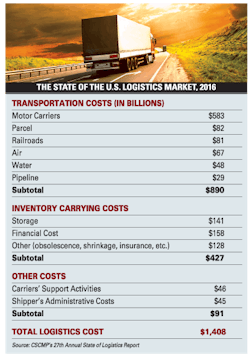With logistics costs rising and technology demands mushrooming, the only way for logistics providers and their customers to survive is by embracing innovation and imagination. Accepting the need to change is not enough, and pursuing "continuous improvement" in managing supply chain processes is the kiss of death for businesses in this era.
That is the message conveyed by both the annual State of Logistics report released in Washington, DC, and by industry speakers at the eft 3PL Summit & Chief Supply Chain Officer Forum held in Chicago, both held in June.
Laying out the challenge in stark numbers is the 27th annual SOL Report, published by the Council of Supply Chain Management Professionals (CSCMP) and sponsored by Penske Logistics.
Since the dawn of trucking deregulation in 1980, the industry has made enormous strides in shrinking annual logistics costs measured as part of Gross Domestic Product, which in the early 1980s was as high as 15%. Since 2010 annual logistics costs have been hovering around 7.9%, but it is questionable how long they can maintain that position in the face of mounting challenges.
In 2015 overall logistics costs in the U.S. climbed to a total of $1.48 trillion, representing a 2.6% increase from the previous year, according to the A.T. Kearney researchers.
Although the growing shortage of qualified truck drivers has been a prime topic of the reports in recent years, this one says softness in truckload demand is temporarily masking the problem, which is expected to reassert itself later. For now, it is being held in check by truckload spot market rates that plunged 15% between the first week of 2015 and the same week this year, and which continued to fall until they started to gradually rise in April and May.
Weakness in truckload demand and pricing also is blamed for what the researchers term a "hiccup" in rail intermodal freight growth in 2015. The numbers released by the Intermodal Association of North America for earlier this year are more encouraging, with domestic container loads registering a 6.4% increase in the first quarter, along with a 3.8% gain in international volumes.
Truck Surplus, Meet Inventory Surplus
This year's report does not break out warehouse-based third-party logistics providers (3PLs) for separate analysis, but quotes Armstrong & Associates' report that 11% of the overall U.S. logistics expenditures in 2015 went to 3PLs that move, store or manage products for others.
The Kearney researchers note that the 3PL industry has grown an average of 7% annually since 2009 and is expected to continue at this pace through 2016 as outsourcing grows steadily in the high-tech, retail and food industries, and even faster in the healthcare and e-commerce sectors.
However, the less-than-truckload (LTL) truckers experienced mixed results over the past year, depending on the industry sector served. Those more focused on e-commerce or retail were able to maintain or slightly grow their business volume. In general, LTL carriers reported relatively stable rates, in part because they have imposed dimensional pricing.
For shippers dimensional pricing has replaced original sin as something to bemoan because rates soared after its adoption by UPS and FedEx, with the cost pressures manifesting themselves most strongly when it comes to business-to-consumer e-commerce.
FedEx ground services revenue grew 9% in 2015 (excluding the newly-acquired GENCO), while UPS ground gained around 3%. Express service revenue at both companies was flat versus 2014, the researchers point out, and overall composite yields declined.
In the meantime, LTL carriers and 3PLs are increasingly turning to the rest of the package carrier industry to handle their last-mile delivery needs. This is a segment of the industry made up of small, localized businesses estimated to number anywhere between 800 and 2,000 firms and which seldom attract attention from logistics researchers, and which received scant attention in the CSCMP report.
Ripe for Disruption
"Over the next decade, the logistics industry will enter a new era," the Kearney researchers state. "Disruptive forces, including technology and operational constraints, threaten to fundamentally change the rules of the game."
All of these are expected to "evolve at breakneck speed and threaten to fundamentally change the rules of the game," the researchers say.
For e-commerce and omni-channel strategies to succeed, both leading logistics customers and service providers agree that better use of analytics and data-sharing is essential.
Logistics customers also are demanding more creative approaches than they have seen so far to finding these solutions coming from their 3PL and 4PL service providers.
"Supply chain transparency continues to grow in importance for shippers and 3PLs," observes Althen. "This is driving significant technological change for 3PLs and shippers alike as they collaborate and share more real-time information to enable data-driven business decisions and meet the growing needs of consumers."
A.T. Kearney's Sean Monahan, one of the SOL report's co-authors, agrees with Althen. "It is a dynamic time for the logistics sector," he says, "because it must deal with changes in the macro economy, development of new business models and rapidly changing technology."
The demand for supply chain transparency will only become more intense, Monahan adds. "The market has seen an increase in shipper demand for visibility and control into all transportation management activities and assets in order to enable their optimization."
Another area where retailers need help from 3PLs involves working off inventories built up in recent years as well as keeping them from growing to unacceptable levels in the future. For the six years prior to 2014 inventories rose to 13.6% of GDP, jumping to 14.5% in 2014, and only began to moderate slightly last year, dropping to 14%.
Adding to the pressure on supply chain managers is the fact that the inventory-carrying costs rose 5.1% last year, compared to a 2.6% increase that took place over the previous five years.
Here is where improved supply chain visibility is needed most, Monahan says. "Hopefully, as organizations become less siloed and more cross-functional in decision-making, we will see inventories become more manageable and drop to below 13% of GDP again."
Adding Imagination to Technology
Participating in the panel discussion following the release of the SOL report, Rick Camacho, vice president of global supply chain operations for candy manufacturer Hershey Company, admits that controlling inventories has been difficult. "When things slow down it takes time to adjust, and at the same time when the economy picks up companies still try to be efficient and burn off inventories. The supply chain is a big ship and it takes a long time to slow it down and a long time to get it moving again."
He adds, "We've definitely seen over the past year that people are getting much smarter about building inventories across the entire supply chain. Everybody is handling less freight and that is directly related to people trying to discount inventory, and get it off the books and into their retail footprint."
Camacho also stresses that more effort is needed in deploying technology to manage the process and create the kind of transparency shippers like his company require. "I think this industry is ripe and ready for disruption," he asserts.
With shippers looking to 3PLs and 4PLs to help them manage the process while wringing out costs, highly-sophisticated transportation management systems have become an essential tool for creating the required visibility. In addition, these TMS solutions are being expanded to render increased visibility and control from end to end in the supply chain, and are increasingly becoming cloud-based.
Off-the-shelf TMS software is not enough, and along with the demand for more size and scope in services this has been driving the merger and acquisition wave we have seen in the 3PL industry over the past few years. It also has led to the growth of larger asset-light 3PLs as well as non-asset-based 4PLs.
"A lead logistics provider (LLP) will manage as many of the logistics activities as a shipper desires, from network design, strategic sourcing and carrier management to load tendering, track and trace, and freight audit and pay," the Kearney researchers stress. "While many shippers have achieved a steady-state solution with an LLP, even more report that the undertaking is a work in process, with systems interfaces and uneven capabilities identified as the key imBeyond technology, what shippers demand even more of from providers can be summed up in one word: imagination. Sheila Taylor, vice president of logistics for Walmart Sam's Club division, drove this point home when she spoke on a panel (moderated by the author) at the eft Logistics Summit. She expressed disappointment that many 3PLs who show up in her office are offering only more of the same services, and rarely offer the kind of imagination and innovation she needs to find solutions to help her serve her customers better.
This point was echoed by top supply chain consultant Jim Tompkins, president of Tompkins International, who also spoke at the eft logistics summit (and who along with the author is a member of the MH&L Editorial Advisory Board).
Simply embracing change isn't good enough anymore, Tompkins offers, observing that continuous improvement—once the end goal of savvy supply chain managers—is now the kiss of death. You need to reach beyond that and even beyond transformation of your processes to aspire to the total metamorphosis of your operation to one that can embrace shippers' needs that range from sourcing raw materials to supporting their end sales, he says.
XPO Logistics CEO Brad Jacobs told the Kearney researchers, "Customers, carriers and 3PLs need to take a collaborative, problem-solving approach to service and cost. Our industry needs to show customers that we bring value-creating ideas to the table, not just capacity. I see the industry evolving in this direction."
David Sparkman is founding editor of ACWI Advance, the newsletter of the American Chain of Warehouses Inc., as well as a member of the MH&L Editorial Advisory Board.









